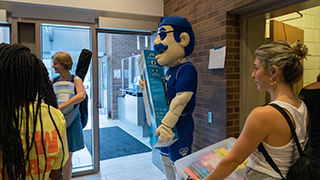Pirate Battalion sends Cadets to Fort Drum for Winter Training
Tuesday, January 17, 2023

Pirate Battalion cadets train at Fort Drum over winter break
Seton Hall’s Military Science and Army ROTC (Reserve Officer Training Corps) program, originally formed in 1893, has long served as a source of commissioning for ambitious, service-oriented college students who aspire to become Army Officers after completing their university education. The program alone, which places a heavy emphasis on training cadets in the fundamentals of infantry tactics and soldiering skills, serves as an invaluable experience in which students learn to become respectable and dedicated leaders.
On top of the training and development that occurs during the academic year, Army ROTC provides cadets the opportunity to compete for additional military training with the fielded forces of our Army. One of these unique opportunities is CTLT (Cadet Troop Leading Training). CTLT typically takes place over the summer and is designed to enable cadets to shadow an active duty platoon leader in order to learn firsthand about the roles and responsibilities that they themselves will take on after commissioning.Cadet Bragg, a senior in the ROTC program and a Seton Hall diplomacy student, and Cadet Chindea, a sophomore cadet in Seton Hall’s Pirate Battalion who is studying electrical engineering at NJIT, were both sent to Fort Drum, NY for a mini-CTLT experience this winter break. During the first week of January 2023, Cadets Bragg and Chindea spent time with aviation and signal units of the Army’s only Alpine unit – the 10th Mountain Division – Climb to Glory!
Fort Drum is home of the 10th Mountain Light Infantry Division, which was originally activated in 1943 and was responsible for the training and deployment of soldiers that were sent to fight in the Italian mountain ranges during WWII. Recently, given the current conflict in Eastern Europe, the Army began placing an increased emphasis on arctic condition training. Today, the 10th Mountain Division remains the most deployed active duty division with over 20 operational assignments since 2001 to both Iraq and Afghanistan in support of Operations Iraqi Freedom and Enduring Freedom.
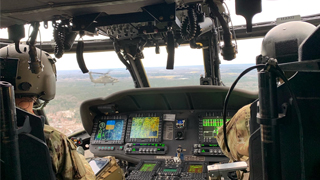
View from the backseat of a UH60M during 2-10 A Co’s multi-ship flight
Cadet Bragg received his branch in November and will commission as an active duty aviation officer this Spring. In line with his branch, Cadet Bragg spent his CTLT with the 2-10 Assault Helicopter Battalion, Alpha Company “Voodoo” and had the opportunity to shadow one of Alpha Company’s Platoon Leaders. In his time with 2-10 Cadet Bragg attended the daily production control meetings in which maintenance of the battalion’s aircraft is discussed. After the morning production control meetings, Cadet Bragg spent time observing the planning process that goes into a multi-ship air assault mission, a training mission that would be flown later in the week.
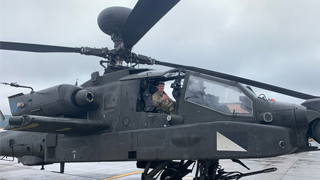
Cadet Bragg in the rear seat of an AH64D at 1-10 C Co.
On January 5th Cadet Bragg sat in one of the crew chief seats of a UH60M Black Hawk during the flight that 2-10 had been planning for the first half of the week. The pilots and crew chiefs of 2-10 flew 2 hours day and 2 hours night, returning to the airfield using night vision goggles. Cadet Bragg said of the experience, “It was great, one of the warrant officers lent me his helmet so I was able to listen to all the communication between pilots and the ground troops during the flight and use night vision goggles on the way back.” After expressing interest in AH64 ‘Apache’ attack helicopters, Cadet Bragg’s sponsor at 2-10 put him in touch with a platoon leader at 1-10 Attack Helicopter Battalion for his last day at Fort Drum. Over at 1-10 Charlie Company, Cadet Bragg got an up close look at the AH64D ‘Apache’ helicopters that they fly there. Later in the day Cadet Bragg attended a brief at Gray Eagle to learn about the capabilities of unmanned aircraft systems. Following the Gray Eagle brief Cadet Bragg sat in on a battalion wide pilots brief about the enemy radar and anti-aircraft systems that the battalion will face at the National Training Center at Fort Irwin California later this year.
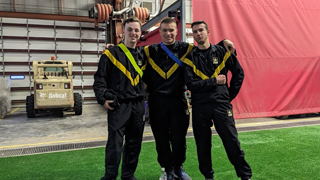
PT with the HHBN Public Affairs Company
Cadet Chindea, who is interested in branching signal upon graduation, was assigned to the divisional level signal company at Fort Drum, NY known as the SIS company (signal & intelligence services). The company is part of the HHBN (Headquarters & Headquarters Battalion) is broken down into three platoons: MCP (main command post), TAC (tactical accessions command) and HUB (responsible for the IT support of operations on base). The former two platoons serve as the providers of tactical communication support via high frequency (HF) satellite equipment wherever HHBN may travel/ be deployed.
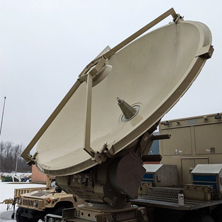
Close up view of a Satellite Transportable Terminal
During the first portion of the work week, cadet Chindea spent time learning about the day-to-day operations of the MCP and TAC platoons, gaining a deep understanding for how soldiers prepare for garrison support, training exercises, and deployment, specifically through the dispatch of maintenance and inventory management objectives. Consequently, he learned about important topics such as environment-dependent responsibilities (tactical vs. garrison) and the fundamentals of S/NIPR (Secure/Non-Secure Internet Protocol Router Network) operation. Furthermore, he was also briefed on the distinct differences between the varied units found within the Army’s Signal Corps force, including division level signal companies (such as Fort Drum’s SIS company), Expeditionary Signal Battalions (ESBs) and brigade level signal battalions. Cade Chindea’s busy schedule working with the MCP and TAC platoons was focused on either preparing for a combat training mission at JRTC (Joint Readiness Training Center) in Fort Polk, Louisiana, or to support upcoming operational assignments in Poland and Romania. During his final two days at Fort Drum, Cadet Chindea observed operations vital to the preparedness of the platoons deploying to missions in eastern Europe aimed at deterring further aggression from Russia.
When asked to describe his experience, Cadet Chindea responded that, “my time at Fort Drum provided me with valuable insight into the inner workings of the Signal Corps, the Army’s communication branch, and will serve as a valuable directive to my future as an officer leading in the maintenance and development of the Army’s communication networks.”
Categories: Campus Life

